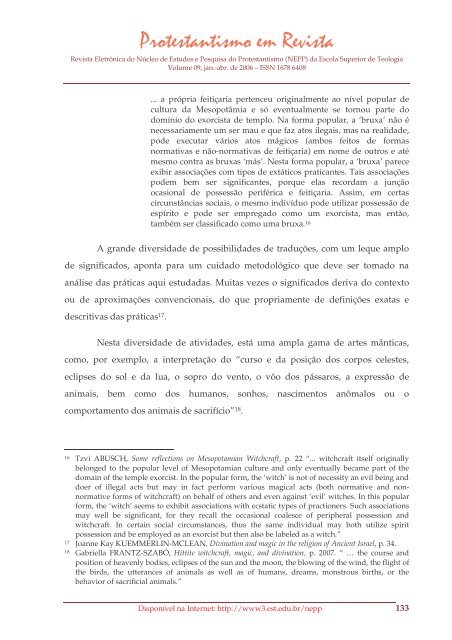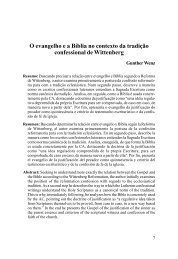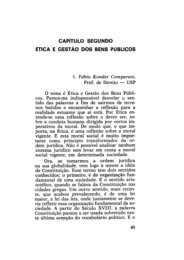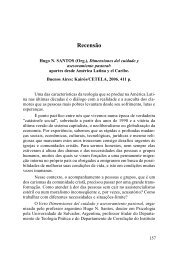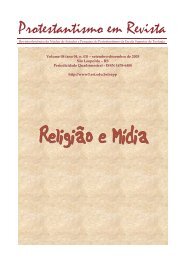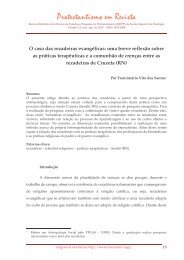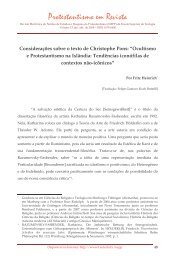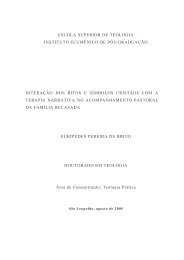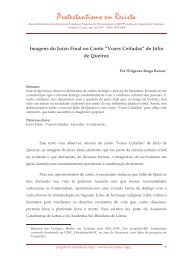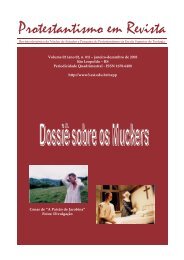Protestantismo em Revista, volume 09 (Ano 05, n.1) - Faculdades EST
Protestantismo em Revista, volume 09 (Ano 05, n.1) - Faculdades EST
Protestantismo em Revista, volume 09 (Ano 05, n.1) - Faculdades EST
You also want an ePaper? Increase the reach of your titles
YUMPU automatically turns print PDFs into web optimized ePapers that Google loves.
<strong>Revista</strong> Eletrônica do Núcleo de Estudos e Pesquisa do <strong>Protestantismo</strong> (NEPP) da Escola Superior de TeologiaVolume <strong>09</strong>, jan.-abr. de 2006 – ISSN 1678 6408... a própria feitiçaria pertenceu originalmente ao nível popular decultura da Mesopotâmia e só eventualmente se tornou parte dodomínio do exorcista de t<strong>em</strong>plo. Na forma popular, a ‘bruxa’ não énecessariamente um ser mau e que faz atos ilegais, mas na realidade,pode executar vários atos mágicos (ambos feitos de formasnormativas e não-normativas de feitiçaria) <strong>em</strong> nome de outros e atémesmo contra as bruxas ‘más’. Nesta forma popular, a ‘bruxa’ pareceexibir associações com tipos de extáticos praticantes. Tais associaçõespod<strong>em</strong> b<strong>em</strong> ser significantes, porque elas recordam a junçãoocasional de possessão periférica e feitiçaria. Assim, <strong>em</strong> certascircunstâncias sociais, o mesmo indivíduo pode utilizar possessão deespírito e pode ser <strong>em</strong>pregado como um exorcista, mas então,também ser classificado como uma bruxa. 16A grande diversidade de possibilidades de traduções, com um leque amplode significados, aponta para um cuidado metodológico que deve ser tomado naanálise das práticas aqui estudadas. Muitas vezes o significados deriva do contextoou de aproximações convencionais, do que propriamente de definições exatas edescritivas das práticas 17 .Nesta diversidade de atividades, está uma ampla gama de artes mânticas,como, por ex<strong>em</strong>plo, a interpretação do “curso e da posição dos corpos celestes,eclipses do sol e da lua, o sopro do vento, o vôo dos pássaros, a expressão deanimais, b<strong>em</strong> como dos humanos, sonhos, nascimentos anômalos ou ocomportamento dos animais de sacrifício” 18 .16 Tzvi ABUSCH, Some reflections on Mesopotamian Witchcraft, p. 22 “... witchcraft itself originallybelonged to the popular level of Mesopotamian culture and only eventually became part of thedomain of the t<strong>em</strong>ple exorcist. In the popular form, the ‘witch’ is not of necessity an evil being anddoer of illegal acts but may in fact perform various magical acts (both normative and nonnormativeforms of witchcraft) on behalf of others and even against ‘evil’ witches. In this popularform, the ‘witch’ se<strong>em</strong>s to exhibit associations with ecstatic types of practioners. Such associationsmay well be significant, for they recall the occasional coalesce of peripheral possession andwitchcraft. In certain social circumstances, thus the same individual may both utilize spiritpossession and be <strong>em</strong>ployed as an exorcist but then also be labeled as a witch.”17 Joanne Kay KUEMMERLIN-MCLEAN, Divination and magic in the religion of Ancient Israel, p. 34.18 Gabriella FRANTZ-SZABÓ, Hittite witchcraft, magic, and divination, p. 2007. “ … the course andposition of heavenly bodies, eclipses of the sun and the moon, the blowing of the wind, the flight ofthe birds, the utterances of animals as well as of humans, dreams, monstrous births, or thebehavior of sacrificial animals.”Disponível na Internet: http://www3.est.edu.br/nepp 133


